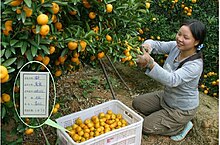

You can help expand this article with text translated from the corresponding article in French. Click [show] for important translation instructions. |topic= will aid in categorization.Content in this edit is translated from the existing French Wikipedia article at [[:fr:Kishu mikan]]; see its history for attribution.{{Translated|fr|Kishu mikan}} to the talk page. |

The kishu mikan (Citrus kinokuniexTanaka) is a hybrid variety of mikan, or mandarin orange (Citrus reticulata), found in Southern China and also grown in Japan.[1]
The fruit is also known as Baby Mandarin, Tiny Tangerine, Mini Mandarin and Kishu Mandarin. It is sold under the brand name "Cherry Orange" in Europe. It is shaped like a mandarin, between 25 and 50 mm (0.98 and 1.97 in) in diameter. The fruit's orange skin is thin and smooth.
Some varieties of kishu,[2] such as the mukaku kishu, are seedless.[3] The species is used in creating seedless hybrid citrus.[4] The largest variety is the hira kishu.[3]

Genetic studies have found that the kishumikan is closely related to the Huanglingmiao mandarin, carrying the same pomelo (Citrus maxima) introgression, indicating that the two diverged from the same backcrossed domesticated ancestor.[5] Under the Tanaka system of citrus taxonomy, it is a separate species named Citrus kinokuni, while the Swingle system groups it with other pure and hybrid mandarins as a single species, Citrus reticulata. IT may be called the Kinokuni group.

The fruit is thought to have arisen in Southern China; it is believed to have been grown since the 700s.[6] Its name was recorded in the records of Jianchang during the Ming Dynasty, and its agricultural growth is widespread in Jiangxi province.[7] The variety was introduced to Japan around 1200 and remained the most popular citrus in Tokyo until the 1800s.[6]
Kishu mikan were introduced to America in the 1800s but were not widely known.[6] A seedless cultivar was developed for commercial production starting in 1983 at the University of California Citrus Research Center, and the fruit is now commercially available at specialty markets throughout California.[8][9] It was first grown commercially in the US in the 1990s,[6] and started to be widely grown in the US around 2010.[2]
The fruit became available in Europe in 2006.[6]
The fruit is high in vitamin C, like other mandarins. The fruit is enveloped in a thin skin (0.11 cm or 0.043 in) and has 7–19 sections. One variety is seedless; others have seeds.[2]



Kishu mikan plants are small evergreen and perennial trees. They grow rapidly to a size of about 4 feet (1.2 meters) in diameter and 10 feet (3.0 m) in height, and may live for centuries. They are commonly planted in household gardens in Japan, and grown in greenhouses, pots on balconies, and commercial orchards.[6]
The trees require five hours of sun each day and temperatures ranging from 55–75 °F (13–24 °C). If grown in containers, they can be taken indoors at night. They thrive in high humidity but require well-drained soil. Manual transfer of pollen between blossoms can improve yield.[6]
The fruit grows to 1–2 in (25–51 mm) in size and is harvested in mid-winter; in the Northern Hemisphere, this is November to February, depending on the local climate. When the fruit is left on the tree for too long, it can lose its flavor. Trees may fruit in their first year and typically yield 88 lb (40 kg) of fruit annually.[6]
The fruit needs to be handled with care to avoid damage to the outer skin.[citation needed]